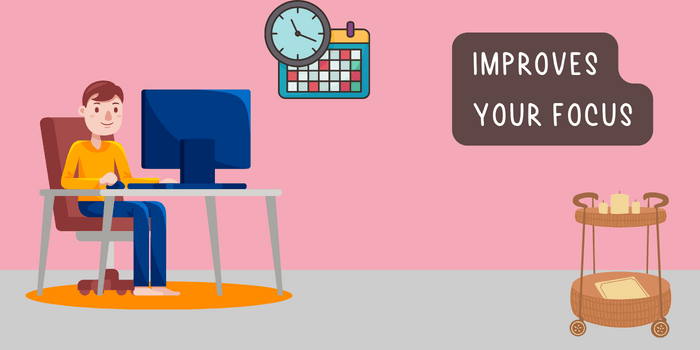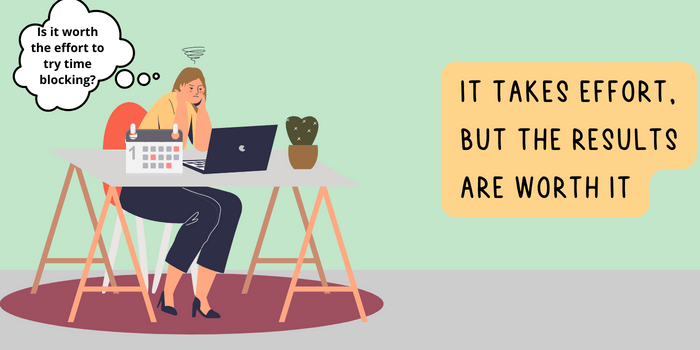I have been time blocking my day in 60-minute chunks for several months now. My overall observation is that it forces me to prioritize more effectively – because when I block time every day, I also block it for a specific activity.
While it has allowed me to be more focused and gives me a sense of control over the day, time blocking is not without its demerits. Overall, time blocking will continue to be one of the main techniques in my productivity toolkit, but I foresee some effort to stay flexible enough to accommodate unforeseen tasks that come up.
I will share some of the pros and cons that I have noticed in my time blocking experience, so you can make a better informed decision and be aware of the challenges when you adopt this practice.
Advantages of time blocking
Improves your focus
The first thing I noticed when I switched to a daily time-blocked schedule is how much more focused I was. By breaking your day into specific blocks of time, you can give your full attention to one task at a time, without feeling guilty.
You are also not constantly switching between tasks and incurring the cognitive switching penalty, where your brain expends its energy loading, flushing, and reloading contextual information for each new task that you switch to.
You feel more in control of your day
Time blocking brings a sense of control into your life. When you create a schedule and systematically allot time to important projects and activities, you get the feeling that you are on top of all the important things in your life.
Time blocking is suitable not just to improve your productivity at work, but also to manage your personal life.
For example, I have blocked out an hour of my morning for my workout. During this time, I am required to do just that.
You will feel more at ease doing the task, relaxing in the knowledge that you have allotted sufficient time for other important tasks as well. You will no longer constantly worry about whether you are neglecting one important task to do another.
Better distribution of time
You can allocate specific blocks of time for specific tasks, be it work, exercise, or spending time with your friends and family.
Time is the most important resource that you have. It is worth thinking about how you should distribute it across competing priorities, in a way that the outcomes delivered are optimal.
With time blocking, you can avoid procrastination and distractions. You have already distributed your time to select activities, so there is less of a reason for your brain to create a conflict by bringing up another activity that you might want to waste time on.
Speaking of procrastination, if you have a go-to procrastination activity – say watching YouTube videos – block some time specifically for YouTube. This will signal to your brain that there is already some time allotted for YouTube videos, so now you need to get back to your task.
Increased productivity
This goes without saying, but you will start noticing that you’re getting more things done when you start time blocking.
I want to add a caveat here about productivity. Being productive does not mean that you will finish all the tasks in your to-do list. That is an impossible goal and one that you should not aspire to.
Whether we like it or not, the tasks that we’re supposed to do are never ending. When you’re done with one task, the next one will jump in to take its place.
What time blocking accomplishes is an improvement from your previous level of productivity. 100% task completion is impossible, no matter what fancy productivity technique you try. What matters is thoughtful prioritization, and completion of tasks that bring maximum value. Time blocking helps with that exceptionally well.
Disadvantages of Time Blocking
It takes effort
Time blocking is an effortful activity. It takes some thinking and prioritizing to plan ahead. It also requires a certain level of discipline and commitment to stick to.
Especially when you begin time blocking, it may feel a little unnatural at first because you’re not allowing yourself to attend to multiple activities as and when you please.
The effort involved is not only in deciding time blocks and activities for each block, but also in sticking to the activity during that time. It will get better when you stick with it for some time. So don’t throw up your hands at the first sign of unease. Give it time.
Lack of spontaneity
This is an important one in the list of disadvantages. Time blocking limits the degree of spontaneity that you can have with your daily activities.
It can be difficult to be flexible and go with the flow if you have your day planned out to the minute.
My solution to this particular problem is to not be too rigid with my schedule. One mistake that I made when I started time-blocking was to plan every minute of the day. I soon realized that that just won’t cut it.
So now I schedule about 4-5 hours for my most important, and I leave another 2-3 hours loose where I can either do shallow work or pick up any other task I want to work on. I also allow myself the flexibility to swap out tasks inside the time blocks if something urgent has come up.
I find this approach to bring a balance to my day and not to feel too restricted.
Find the right balance
Time blocking is an excellent productivity technique if you are able to find the right balance between flexibility and efficiency.
Be mindful of the usual pitfalls such as the desire to plan every minute of your day, which will ultimately render this technique completely useless.
Start by time blocking just 2-4 hours a day. Create a general schedule with some flexibility.
You may have to experiment a little bit to find the right balance that works for you.




